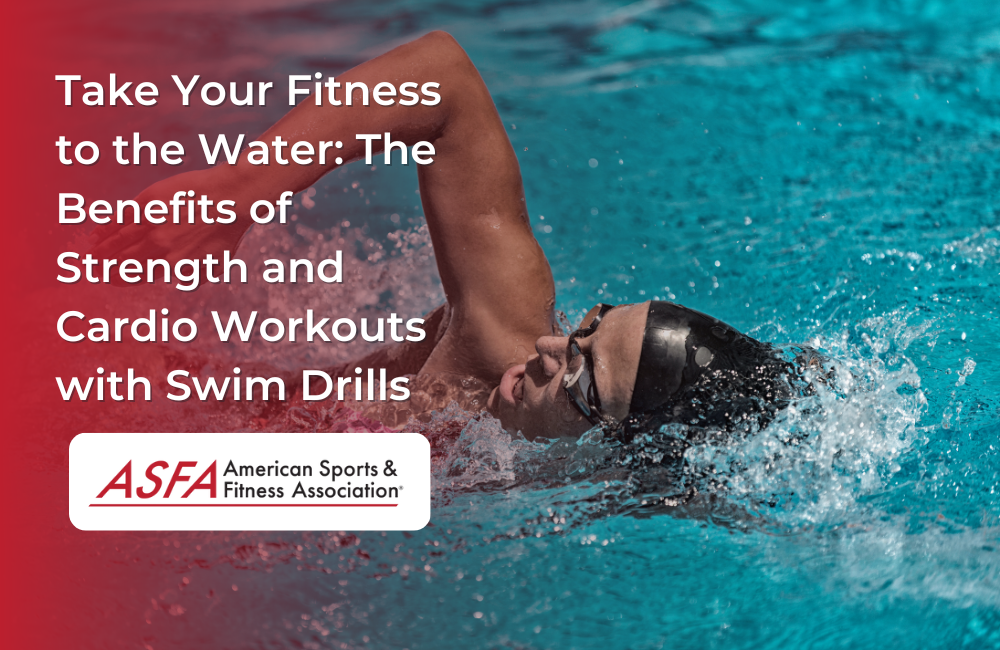Swimming is an excellent form of exercise that offers a range of benefits for your physical and mental health. Not only is it a great low-impact activity that is easy on your joints, but it also provides a full-body workout that can help improve strength, cardiovascular fitness, and endurance. In this blog post, we will explore the benefits of strength and cardio workouts with swim drills, as recommended by the American Sports and Fitness Association (ASFA).
The Benefits of Swimming for Strength and Cardio Workouts
- Low-Impact Exercise
Swimming is a low-impact exercise that is easy on your joints, making it an ideal option for individuals with joint pain or injuries.
- Full-Body Workout
Swimming provides a full-body workout that engages all major muscle groups, including the arms, legs, back, and core.
- Improves Cardiovascular Fitness
Swimming is an excellent cardio exercise that can help improve cardiovascular fitness and endurance.
- Builds Strength and Muscle Tone
Swimming can help build strength and muscle tone, particularly in the upper body and core.
- Reduces Stress and Anxiety
Swimming is a great way to reduce stress and anxiety, providing a calming and meditative experience that can help improve mental health and well-being.
Swim Drills for Strength and Cardio Workouts
- Freestyle Stroke
The freestyle stroke is the most common swimming stroke, and is great for improving cardiovascular fitness and endurance. To perform the freestyle stroke, lie face-down in the water and kick your legs in a flutter motion. Alternately reach your arms over your head and pull them back down to your sides, using your core and upper body muscles to power your movements.
- Breaststroke
The breaststroke is a great option for building strength and muscle tone, particularly in the chest, shoulders, and arms. To perform the breaststroke, lie face-down in the water and bring your arms together in front of your body, then push them out and around to the sides before bringing them back in again. At the same time, bring your legs up to your buttocks and then extend them out and around to the sides, before bringing them back together again.
- Backstroke
The backstroke is an excellent option for improving posture and back strength, as well as providing a great cardio workout. To perform the backstroke, lie on your back in the water and kick your legs in a flutter motion. Reach your arms over your head and pull them down to your sides, using your back muscles to power the movement.
- Butterfly Stroke
The butterfly stroke is a challenging stroke that can help build upper body strength and muscle tone. To perform the butterfly stroke, lie face-down in the water and kick your legs together in a dolphin motion. Bring your arms forward over your head and then pull them back down to your sides, using your chest, shoulder, and arm muscles to power the movement.
- Treading Water
Treading water is a great exercise for improving endurance and cardiovascular fitness. To tread water, move your arms and legs in a sculling motion to keep yourself afloat.
- Pool Sprints
Pool sprints are a great way to get a high-intensity cardio workout in the water. Swim as fast as you can from one end of the pool to the other, and then rest for a set period of time before repeating the sprint.
Incorporating swim drills into your workout routine can help you achieve a full-body workout that provides both strength and cardio benefits. Remember to start slowly and gradually build up your endurance and strength over time. Always listen to your body, and consult with a healthcare professional if you have any concerns or medical conditions. Here are a few tips to help you get started:
- Warm Up and Cool Down
Just like with any other form of exercise, it's important to warm up before you begin your swim workout. This can help prevent injury and prepare your muscles for the workout ahead. A few minutes of light swimming or dynamic stretches can be a great way to warm up. After your workout, be sure to cool down by swimming a few easy laps and doing some static stretches.
- Vary Your Workout
Swimming offers a variety of strokes and drills that can be used to target different muscle groups and provide a full-body workout. Varying your workout can help prevent boredom and keep you motivated to continue swimming.
- Use Equipment
Swimming equipment, such as kickboards, pull buoys, and paddles, can be used to add variety to your swim workout and target specific muscle groups. For example, using a kickboard can help strengthen your legs, while using paddles can help build upper body strength.
- Focus on Technique
Proper technique is important when swimming, both for efficiency and to prevent injury. Take the time to learn proper swim technique, and focus on form and technique during your swim workouts.
- Set Goals
Setting goals can help keep you motivated and on track with your swim workouts. Whether you're working on improving your endurance, building strength, or learning a new stroke, setting achievable goals can help you stay focused and committed to your swimming routine.
In conclusion, incorporating swim drills into your workout routine can provide a great low-impact option for both strength and cardio workouts. Swimming is a full-body workout that can help improve cardiovascular fitness, endurance, strength, and muscle tone, while also reducing stress and anxiety. Remember to start slowly, warm up and cool down properly, and vary your workout to keep things interesting. With dedication and consistency, swimming can be a great addition to your fitness routine.





